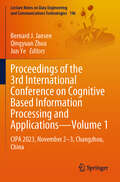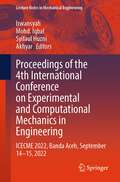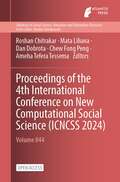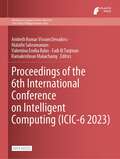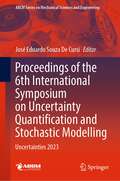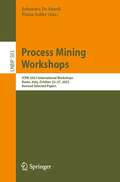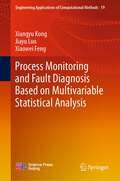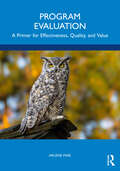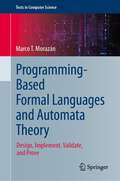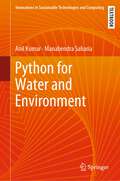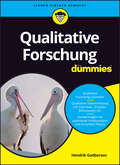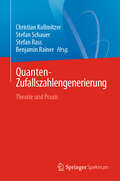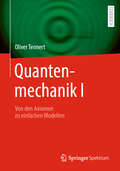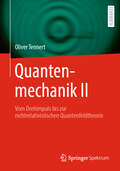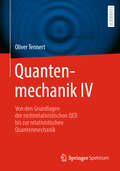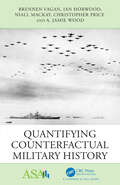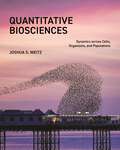- Table View
- List View
Proceedings of the 3rd International Conference on Cognitive Based Information Processing and Applications–Volume 1: CIPA 2023, November 2–3, Changzhou, China (Lecture Notes on Data Engineering and Communications Technologies #196)
by Jun Ye Bernard J. Jansen Qingyuan ZhouThis book contains papers presented at the 3rd International Conference on Cognitive- based Information Processing and Applications (CIPA) in Changzhou, China, from November 2–3, 2023. The papers represent the various technological advancements in theory, technology and application of artificial intelligence, including precision mining, intelligent computing, deep learning, and all other theories, models, and technologies related to artificial intelligence. It caters to postgraduate students, researchers, and practitioners specializing and working in the area of cognitive-inspired computing and intelligent computing. The book represents Volume 1 for this conference proceedings, which consists of a 3-volume book series.
Proceedings of the 4th International Conference on Experimental and Computational Mechanics in Engineering: ICECME 2022, Banda Aceh, September 14–15, 2022 (Lecture Notes in Mechanical Engineering)
by Irwansyah Mohd. Iqbal Syifaul Huzni AkhyarThis book gathers a selection of peer-reviewed papers presented at the 4th International Conference on Experimental and Computational Mechanics in Engineering (ICECME 2022), held as a virtual conference and organized by Universitas Syiah Kuala, Banda Aceh, Indonesia, on September 14–15, 2022.This book, prepared by international scientists and engineers, covers the latest advances in computational mechanics, metallurgy and material science, energy systems, manufacturing processing systems, industrial and system engineering, biomechanics, artificial intelligence, micro-/nano-engineering, micro-electro-mechanical system, machine learning, mechatronics, and engineering design. This book is intended for academics, including graduate students and researchers, as well as industrial practitioners working in the areas of experimental and computational mechanics.
Proceedings of the 4th International Conference on New Computational Social Science (Advances in Social Science, Education and Humanities Research #844)
This is an open access book. Welcome to The 4th International Conference on New Computational Social Science which will be held on March 08-10, 2024, Shenzhen, Guangdong, China. The focus of this conference are mainly five aspects: Big data acquisition and analysis, Integration of qualitative research and quantitative research, Sociological Internet experiment research, Application of ABM simulation method in Sociology Research, Research and development of new social computing tools. With the rapid development of information technology, especially sweeping progress in the Internet of things, cloud computing, social networks, social media and big data. As a data-intensive science, social computing is an emerging thing that leverages the capacity to collect and analyze data with an unprecedented breadth, depth and scale. It represents a new computing paradigm and an interdisciplinary research and application field. A broad comprehension of major topics involved in social computing is important for both scholars and practitioners. This is an international conference on vary research aspects of Computational Social Science. We will present and discuss key concepts and analyze state-of-the-art of the field. The conference not only sheds insights on social computing, but also affords conduit for future research in the field. Social computing has two distinct trends: One is on the social science issues, such as computational social science, computational sociology, social network analysis, etc; The other is on the use of computational techniques, such as social use, hedonic use and generative use. Finally some new challenges ahead are summarized, including interdisciplinary cooperation and training, big data sharing for scientific data mashups, and privacy protect.
Proceedings of the 6th International Conference on Intelligent Computing (Advances in Computer Science Research #107)
This is an open access book. PECTEAM, being held for a period of two days, aims to witness the development of technologies in all technical and management domains. The major event in the conference is paper presentations on the latest advances in Engineering and Management disciplines from National and International academic sectors. Special emphasis is given to update newer technologies by Keynote speakers. PECTEAM is a premier platform for researchers and industry practitioners to share their new and innovative ideas, original research findings and practical development experiences in Engineering and Management through high quality peer reviewed papers.
Proceedings of the 6th International Symposium on Uncertainty Quantification and Stochastic Modelling: Uncertainties 2023 (Lecture Notes in Mechanical Engineering)
by José Eduardo Souza De CursiThis proceedings book covers a wide range of topics related to uncertainty analysis and its application in various fields of engineering and science. It explores uncertainties in numerical simulations for soil liquefaction potential, the toughness properties of construction materials, experimental tests on cyclic liquefaction potential, and the estimation of geotechnical engineering properties for aerogenerator foundation design. Additionally, the book delves into uncertainties in concrete compressive strength, bio-inspired shape optimization using isogeometric analysis, stochastic damping in rotordynamics, and the hygro-thermal properties of raw earth building materials. It also addresses dynamic analysis with uncertainties in structural parameters, reliability-based design optimization of steel frames, and calibration methods for models with dependent parameters. The book further explores mechanical property characterization in 3D printing, stochastic analysis in computational simulations, probability distribution in branching processes, data assimilation in ocean circulation modeling, uncertainty quantification in climate prediction, and applications of uncertainty quantification in decision problems and disaster management. This comprehensive collection provides insights into the challenges and solutions related to uncertainty in various scientific and engineering contexts.
Process Mining Workshops: ICPM 2023 International Workshops, Rome, Italy, October 23–27, 2023, Revised Selected Papers (Lecture Notes in Business Information Processing #503)
by Johannes De Smedt Pnina SofferThis volume constitutes the revised selected papers of several workshops which were held in conjunction with the 5th International Conference on Process Mining, ICPM 2023, held in Rome, Italy, in October 23–27, 2023.The 38 revised full papers presented in this book were carefully reviewed and selected from 85 submissions. The book also contains one invited talk. ICPM 2023 presented the following six workshops:– 4th International Workshop on Event Data and Behavioral Analytics (EdbA)– 4th International Workshop on Leveraging Machine Learning in Process Mining (ML4PM)– 6th International Workshop on Process-Oriented Data Science for Healthcare (PODS4H)– 8th International Workshop on Process Querying, Manipulation, and Intelligence (PQMI)– 2nd International Workshop on Education Meets Process Mining (EduPM)– 2nd International Workshop on Collaboration Mining for Distributed Systems (COMINDS).
Process Monitoring and Fault Diagnosis Based on Multivariable Statistical Analysis (Engineering Applications of Computational Methods #19)
by Xiangyu Kong Jiayu Luo Xiaowei FengThis book reports the developments of the Total Least Square (TLS) algorithms for parameter estimation and adaptive filtering. Specifically, this book introduces the authors’ latest achievements in the past 20 years, including the recursive TLS algorithms, the approximate inverse power iteration TLS algorithm, the neural based MCA algorithm, the neural based SVD algorithm, the neural based TLS algorithm, the TLS algorithms under non-Gaussian noises, performance analysis methods of TLS algorithms, etc. In order to faster the understanding and mastering of the new methods provided by this book for readers, before presenting each new method in each chapter, a specialized section is provided to review the closely related several basis models. Throughout the book, large of procedure of new methods are provided, and all new algorithms or methods proposed by us are tested and verified by numerical simulations or actual engineering applications. Readers will find illustrative demonstration examples on a range of industrial processes to study. Readers will find out the present deficiency and recent developments of the TLS parameter estimation fields, and learn from the the authors’ latest achievements or new methods around the practical industrial needs. In my opinion, this book can be assimilated by advanced undergraduates and graduate (PH.D.) students, as well as statisticians, because of the new tools in data analysis, applied mathematics experts, because of the novel theories and techniques that we propose, engineers, above all for the applications in control, system identification, computer vision, and signal processing.
Product Lifecycle Management. Leveraging Digital Twins, Circular Economy, and Knowledge Management for Sustainable Innovation: 20th IFIP WG 5.1 International Conference, PLM 2023, Montreal, QC, Canada, July 9–12, 2023, Revised Selected Papers, Part I (IFIP Advances in Information and Communication Technology #701)
by Abdelaziz Bouras Ramy Harik Louis Rivest Felix Nyffenegger Christophe DanjouThis two-volume set IFIP AICT 701-702 constitutes the refereed post-conference proceedings of the 20th IFIP WG 5.1 International Conference on Product Lifecycle Management: Leveraging Digital Twins, Circular Economy, and Knowledge Management for Sustainable Innovation, PLM 2023, held in Montreal, QC, Canada, during July 9–12, 2023. The 61 regular papers included in this book were carefully reviewed and selected from 116 submissions. They are organized in the following thematic sections: Part I: Technology implementation: augmented reality, CPS and digital twin; organisation: knowledge management, change management, frameworks for project and service development; modelisation : CAD and collaboration, model-based system engineering and building information modeling. Part II: Circular economy: characterization, criteria and implementation; interoperability technology: blockchain, IoT and ontologies for data exchange; learning and training: from AI to a human-centric approach; smart processes: prediction, optimization and digital thread.
Product Lifecycle Management. Leveraging Digital Twins, Circular Economy, and Knowledge Management for Sustainable Innovation: 20th IFIP WG 5.1 International Conference, PLM 2023, Montreal, QC, Canada, July 9–12, 2023, Revised Selected Papers, Part II (IFIP Advances in Information and Communication Technology #702)
by Abdelaziz Bouras Ramy Harik Louis Rivest Felix Nyffenegger Christophe DanjouThis two-volume set IFIP AICT 701-702 constitutes the refereed post-conference proceedings of the 20th IFIP WG 5.1 International Conference on Product Lifecycle Management: Leveraging Digital Twins, Circular Economy, and Knowledge Management for Sustainable Innovation, PLM 2023, held in Montreal, QC, Canada, during July 9–12, 2023. The 61 regular papers included in this book were carefully reviewed and selected from 116 submissions. They are organized in the following thematic sections: Part I: Technology implementation: augmented reality, CPS and digital twin; organisation: knowledge management, change management, frameworks for project and service development; modelisation : CAD and collaboration, model-based system engineering and building information modeling. Part II: Circular economy: characterization, criteria and implementation; interoperability technology: blockchain, IoT and ontologies for data exchange; learning and training: from AI to a human-centric approach; smart processes: prediction, optimization and digital thread.
Program Evaluation: A Primer for Effectiveness, Quality, and Value
by Arlene FinkThis timely, unique, and insightful book provides students and practitioners with the tools and skills needed to evaluate social and policy programs across a range of disciplines—from public health to social work to education—enabling the allocation of scarce human and financial resources to advance the health and well-being of individuals and populations. The chapters are organized according to the main tasks involved in conducting an evaluation to produce unbiased evidence of program effectiveness, quality, and value. The chapters include methods for selecting and justifying evaluation questions or hypotheses, designing evaluations, sampling participants, selecting information sources, and ensuring reliable and valid measurement. The final section of the book is focused around managing and analyzing data and transparently reporting the results in written and oral form. The book features international case studies throughout, covers quantitative, qualitative, and mixed-method approaches, and is also informed by new online methods developed during the COVID-19 pandemic. Among the book’s unique features is a focus on international standards for conducting ethical evaluations and avoiding research misconduct. Also featuring checklists, example forms, and summaries of the key ideas and topics, this very practical book is essential reading for students in the social, behavioral, and health sciences, and will be a key resource for professionals in the field.
Program Evaluation: A Primer for Effectiveness, Quality, and Value
by Arlene FinkThis timely, unique, and insightful book provides students and practitioners with the tools and skills needed to evaluate social and policy programs across a range of disciplines—from public health to social work to education—enabling the allocation of scarce human and financial resources to advance the health and well-being of individuals and populations. The chapters are organized according to the main tasks involved in conducting an evaluation to produce unbiased evidence of program effectiveness, quality, and value. The chapters include methods for selecting and justifying evaluation questions or hypotheses, designing evaluations, sampling participants, selecting information sources, and ensuring reliable and valid measurement. The final section of the book is focused around managing and analyzing data and transparently reporting the results in written and oral form. The book features international case studies throughout, covers quantitative, qualitative, and mixed-method approaches, and is also informed by new online methods developed during the COVID-19 pandemic. Among the book’s unique features is a focus on international standards for conducting ethical evaluations and avoiding research misconduct. Also featuring checklists, example forms, and summaries of the key ideas and topics, this very practical book is essential reading for students in the social, behavioral, and health sciences, and will be a key resource for professionals in the field.
Programming-Based Formal Languages and Automata Theory: Design, Implement, Validate, and Prove (Texts in Computer Science)
by Marco T. MorazánThis textbook introduces formal languages and automata theory for upper-level undergraduate or beginning graduate students. While it contains the traditional mathematical development usually employed in computational theory courses, it is also quite different from many of them. Machines, grammars, and algorithms developed as part of a constructive proof are intended to be rendered as programs. The book is divided into four parts that build on each other. Part I reviews fundamental concepts. It introduces programming in FSM and reviews program design. In addition, it reviews essential mathematical background on sets, relations, and reasoning about infinite sets. Part II starts the study of formal languages and automata theory in earnest with regular languages. It first introduces regular expressions and shows how they are used to write programs that generate words in a regular language. Given that regular expressions generate words, it is only natural to ask how a machine can recognize words in a regular language. This leads to the study of deterministic and nondeterministic finite-state machines. Part III starts the exploration of languages that are not regular with context-free languages. It begins with context-free grammars and pushdown automata to generate and recognize context-free languages, and it ends with a discussion of deterministic pushdown automata and illustrates why these automatons are fundamentally different from nondeterministic pushdown automata. Part IV eventually explores languages that are not context-free, known as context-sensitive languages. It starts by discussing the most powerful automaton known to mankind: the Turing machine. It then moves to grammars for context-sensitive languages, and their equivalence with Turing machines is explored. The book ends with a brief chapter introducing complexity theory and explores the question of determining if a solution to a problem is practical.
Proportions and Their Music: What Fractions and Tone Sequences Have to Do with Each Other
by Karlheinz SchüfflerSounds can be harmonic, number sequences too - a coincidence?This book deals with a musical theory of proportions, i.e. the ancient doctrine of proportions as the oldest and most important common anchorage of the two cultural sciences mathematics and music.The musical theory of tones, intervals, tetrachords, sounds and scales is in fact the exact musical image of the laws of arithmetic and its symmetries in the set of rules of playing with numbers, their proportions and their medievals. Alone the miracle of the so-called Harmonia perfecta maxima 6 - 8 - 9 - 12, whose proportions determine the fifth as well as the fourth, form the octave and have the brazen whole tone in their center, shaped the musical edifice of Pythagorean music for thousands of years. This elementary chain of proportions 6 : 8 : 9 : 12 is, moreover, completely symmetrical and built up from the arithmetic as well as from the harmonic medieta of the octave numbers 6 and 12.This book develops the theory of proportions as a mathematical science and always contrasts it with the musical motivation by means of numerous examples. The main idea is the derivation of a theory of symmetry from the Harmonia perfecta maxima to the Harmonia perfecta infinita abstracta, a process of unlimited tone generations by Babylonian mean iterations. From this, both the classical-antique diatonic is simultaneously extracted and the path "from the monochord to the organ" is re-examined.Finally, the work contains a mathematically guided introduction to the ancient tetrachordics as well as to the church tonal scales and concludes with an excursion into the sound worlds of the organ. Here the "foot-number rule of the organ" leads us by means of examples into the world of the tonal dispositions of this instrument and shows the omnipresence of the ancient theory of proportions. This book is suitable for anyone with an interest in mathematics and music.This book is a translation of the original German 1st edition Proportionen und ihre Musik by Karlheinz Schüffler, Springer-Verlag GmbH Germany, part of Springer Nature in 2019. The translation was done with the help of artificial intelligence (machine translation by the service DeepL.com). A subsequent human revision was done primarily in terms of content, so that the book will read stylistically differently from a conventional translation. Springer Nature works continuously to further the development of tools for the production of books and on the related technologies to support the authors.
Prüfungstraining Theoretische Physik – Analytische Mechanik: Klausuren mit ausführlichen Lösungen
by Markus EichhornDieses Lehrbuch bietet mit 60 Übungsaufgaben in Form von 15 Klausuren eine ideale Vorbereitungsmöglichkeit auf die Klausur der Analytischen Mechanik und fokussiert sich dabei vor allem auf Aufgaben der Theoretischen Physik. Mit Lösungshinweisen und ausführlichen Lösungswegen bietet es eine Unterstützung zum Verständnis und zur Anwendung des Vorlesungsstoffs auf neue Probleme. Daneben werden weiterführende Informationen bereitgestellt, um die Bedeutung der Analytischen Mechanik als Grundlage der modernen Physik deutlich zu machen.Es werden typische Aufgaben, wie der Harmonische Oszillator, das Kepler-Problem, die Anwendung des Noether-Theorems, gekoppelte Schwingungen und Variationsrechnung in den einzelnen Klausuren behandelt. Einige Aufgaben wie die schwingende Saite oder die schwingende Membran beschäftigen sich mit einer Beschreibung, die im Zuge der Feldtheorie von zentraler Bedeutung wird. Wieder andere Aufgaben bereiten auf den Übergang vonder Hamilton’schen Mechanik zur Quantenmechanik vor.Das Buch richtet sich an Studierende, die sich auf ihre Klausur zur Analytischen Mechanik vorbereiten, kann aber auch zum Lösen von Übungsaufgaben während des Semesters hilfreich sein. Auch Dozierende können hier Inspiration für ihre Übungsaufgaben oder Klausuren finden.
Python for Accounting and Finance: An Integrative Approach to Using Python for Research
by Sunil KumarThis book is a comprehensive guide to the application of Python in accounting, finance, and other business disciplines. This book is more than a Python tutorial; it is an integrative approach to using Python for practical research in these fields. The book begins with an introduction to Python and its key libraries. It then covers real-world applications of Python, covering data acquisition, cleaning, exploratory data analysis, visualization, and advanced topics like natural language processing, machine learning, predictive analytics, and deep learning. What sets this book apart is its unique blend of theoretical knowledge and real-world examples, supplemented with ready-to-use code. It doesn't stop at the syntax; it shows how to apply Python to tackle actual analytical problems. The book uses case studies to illustrate how Python can enhance traditional research methods in accounting and finance, not only allowing the reader to gain a firm understanding of Pythonprogramming but also equipping them with the skills to apply Python to accounting, finance, and broader business research. Whether you are a PhD student, a professor, an industry professional, or a financial researcher, this book provides the key to unlocking the full potential of Python in research.
Python for Water and Environment (Innovations in Sustainable Technologies and Computing)
by Anil Kumar Manabendra SahariaThis textbook delves into the practical applications of surface and groundwater hydrology, as well as the environment. The Part I, "Practical Python for a Water and Environment Professional," guides readers through setting up a scientific computing environment and conducting exploratory data analysis and visualization using reproducible workflows. The Part II, "Statistical Modeling in Hydrology," covers regression models, time series analysis, and common hypothesis testing. The Part III, "Surface and Subsurface Water," illustrates the use of Python in understanding key concepts related to seepage, groundwater, and surface water flows. Lastly, the Part IV, "Environmental Applications," demonstrates the application of Python in the study of various contaminant transport phenomena.
Qualitative Forschung für Dummies (Für Dummies)
by Hendrik GodbersenSo werden aus Worten Daten Sie wollen bei einer Untersuchung mehr über Motive und Anliegen der zu untersuchenden Gruppe wissen? Dann helfen Ihnen die Methoden der qualitativen Forschung weiter. Hendrik Godbersen erklärt Ihnen von der Pike auf, was Sie über qualitative Forschung wissen müssen, um selbst eine Untersuchung vorzunehmen. Er erläutert dabei den qualitativen Forschungsansatz, Ziele und Designs sowie die Gütekriterien. Außerdem vermittelt er Ihnen, wie Sie Forschungsarbeiten strukturieren, Daten erheben und auswerten und zuletzt die Ergebnisse interpretieren. So wird Ihre Untersuchung gewiss ein Erfolg. Sie erfahren Wie Sie Interviews führen und Gruppendiskussionen leiten Wie Sie qualitative Daten aufzeichnen und transkribieren Wie Sie die richtige Methode für die Datenauswertung nutzen Wie Sie die Qualität Ihrer Untersuchung sichern
Quanten-Zufallszahlengenerierung: Theorie und Praxis
by Stefan Rass Stefan Schauer Christian Kollmitzer Benjamin RainerDieses Buch bietet einen Überblick über die neuesten Implementierungen von Quanten-Zufallszahlengeneratoren (QRNGs) und untersucht insbesondere deren Beziehung zu klassischen statistischen Zufallsmodellen und numerischen Techniken zur Berechnung von Zufallszahlen. Der Leser - der idealerweise einen Hintergrund in klassischer Statistik, Informatik oder Kryptographie hat - wird Schritt für Schritt in die Welt der Quantenbits eingeführt, und es werden explizite Beziehungen zwischen QRNGs und ihren klassischen Gegenstücken aufgezeigt. Die Erzeugung von Zufallszahlen ist eine wichtige Säule der Kryptographie. Die Nutzung des Zufalls, der Quantenphänomenen innewohnt, ist ein sich rasch entwickelnder Zweig der Quantenkryptografie mit unzähligen Anwendungen für die Zukunft. Der Wert der Quantenzufälligkeit für kryptografische Zwecke wird empirisch durch statistische Auswertungen der Leistung von QRNGs im Vergleich zu klassischen Techniken zur Erzeugung echter und pseudozufälliger Zahlen nachgewiesen. Das Buch bietet dann einen Überblick über die technischen Implementierungen von QRNGs, bevor eine abschließende Diskussion über die wichtigsten Errungenschaften und verbleibenden Hindernisse auf diesem Gebiet die Berichterstattung abrundet und gleichzeitig die Tür für zukünftige Forschungsrichtungen öffnet.
Quantenmechanik I: Von den Axiomen zu einfachen Modellen
by Oliver TennertIn einer umfassenden Darstellung entwickeln und vertiefen die vier Bände dieses Lehrbuchs das Gebäude der nichtrelativistischen Quantenmechanik, weshalb sie auch bestens als Nachschlagewerk geeignet sind. Der erste Band beginnt mit einer anekdotenreichen und spannenden historischen Überblicksdarstellung, die die Hauptprotagonisten der Quantentheorie und wichtige Meilensteine ihres Wirkens vorstellt. Im Folgenden wird dann die Formulierung im Hilbert-Raum axiomatisch entwickelt und wichtige Grundlagenthemen behandelt: die eindimensionalen Probleme, der harmonische Oszillator und die WKB-Näherung als Bindeglied zur klassischen Physik. Besonderheiten: Auch komplizierte Zusammenhänge werden illustrativ und klar erklärt. Zahlreiche mathematische Einschübe erläutern allgemeine mathematische Zusammenhänge. Besondere Highlights des Buches sind die frühe Entwicklung von Propagatormethoden, die ausführliche mathematische Behandlung von kohärenten und gequetschten Zuständen des harmonischen Oszillators, sowie die gründliche Untersuchung des klassischen Grenzfalls. Inhalt 1. Historischer Abriss: Der Weg zur Quantenmechanik - 2. Der theoretische Formalismus der Quantenmechanik - 3. Eindimensionale Probleme - 4. Der harmonische Oszillator in der Quantenmechanik - 5. Die WKB-Näherung und der klassische Grenzfall Zielgruppe: Das Buch richtet sich sowohl an Bachelor- als auch an Masterstudierende sowie ihre Lehrenden. Aufgrund seines mehrbändigen Charakters, der breiten Themenvielfalt und Bezügen zu wissenschaftlichen Originalarbeiten allerdings ein Muss für jedes Bücherregal einer in der Physik tätigen Person. Vorkenntnisse: Vorausgesetzt werden Kenntnisse der Theoretischen Mechanik, der Elektrodynamik und der Speziellen Relativitätstheorie, sowie der Analysis, der linearen Algebra und der Funktionentheorie.
Quantenmechanik II: Vom Drehimpuls bis zur nichtrelativistischen Quantenfeldtheorie
by Oliver TennertIn einer umfassenden Darstellung entwickeln und vertiefen die vier Bände dieses Lehrbuchs das Gebäude der nichtrelativistischen Quantenmechanik, weshalb sie auch bestens als Nachschlagewerk geeignet sind. Der zweite Band behandelt den quantenmechanischen Drehimpuls, sowie Symmetrien in der nichtrelativistischen Quantenmechanik. Anschließend wird das wichtige Anwendungsgebiet der dreidimensionalen Probleme sowohl auf algebraischem Wege als auch mit analytischen Methoden untersucht. Es schließen sich Kapitel zu Teilchen in elektromagnetischen Feldern und zum großen Themenkomplex identischer Teilchen an, welcher nahtlos zur Feldquantisierung weiterführt. Besonderheiten: Auch komplizierte Zusammenhänge werden illustrativ und klar erklärt. Zahlreiche mathematische Einschübe erläutern allgemeine mathematische Zusammenhänge. Besondere Highlights des Buches sind der algebraische Beweis zur Ganzzahligkeit des Bahndrehimpulses, die ausführliche Untersuchung des Zusammenhangs zwischen Clifford-Algebren und Spinoren, sowie ein Linearisierungsansatz für die Schrödinger-Gleichung. Die Mathematik der Eichtheorien bietet eine zusammenhängende Formulierung sehr vieler topologischer Phänomene wie magnetischer Monopole, des Aharonov–Bohm-Effekts oder von Landau-Niveaus. Inhalt 1. Theorie des Drehimpulses I - 2. Symmetrien in der Quantenmechanik I - 3. Dreidimensionale Probleme - 4. Teilchen in elektromagnetischen Feldern - 5. Theorie des Drehimpulses II - 6. Identische Teilchen und nichtrelativistische Quantenfeldtheorie Zielgruppe: Das Buch richtet sich sowohl an Bachelor- als auch an Masterstudierende sowie ihre Lehrenden. Aufgrund seines mehrbändigen Charakters, der breiten Themenvielfalt und Bezügen zu wissenschaftlichen Originalarbeiten allerdings ein Muss für jedes Bücherregal einer in der Physik tätigen Person. Vorkenntnisse: Vorausgesetzt werden Kenntnisse der Theoretischen Mechanik, der Elektrodynamik und der Speziellen Relativitätstheorie, sowie der Analysis, der linearen Algebra und der Funktionentheorie.
Quantenmechanik III: Näherungsverfahren, zeitabhängige Systeme und Streutheorie
by Oliver TennertIn einer umfassenden Darstellung entwickeln und vertiefen die vier Bände dieses Lehrbuchs das Gebäude der nichtrelativistischen Quantenmechanik, weshalb sie auch bestens als Nachschlagewerk geeignet sind. Der dritte Band stellt wichtige Näherungsverfahren für zeitunabhängige Probleme vor und führt anschließend über die Behandlung zeitabhängiger Systeme hin zum großen Themengebiet der Streutheorie. Besonderheiten: Auch komplizierte Zusammenhänge werden illustrativ und klar erklärt. Zahlreiche mathematische Einschübe erläutern allgemeine mathematische Zusammenhänge. Besondere Highlights des Buches sind die Ableitung emergenter Eichtheorien aus der Born–Oppenheimer-Näherung heraus, die exakte Lösung für das Wasserstoffmolekül-Ion als Zwei-Zentren-Problem und für das Coulomb-Streuproblem, sowie die Untersuchung der analytischen Struktur der S-Matrix, einschließlich der Herleitung wichtiger Dispersionsrelationen. Inhalt 1. Näherungsverfahren für gebundene Zustände - 2. Zeitabhängige Systeme und Übergänge - 3. Streutheorie Zielgruppe: Das Buch richtet sich sowohl an Bachelor- als auch an Masterstudierende sowie ihre Lehrenden. Aufgrund seines mehrbändigen Charakters, der breiten Themenvielfalt und Bezügen zu wissenschaftlichen Originalarbeiten allerdings ein Muss für jedes Bücherregal einer in der Physik tätigen Person. Vorkenntnisse: Vorausgesetzt werden Kenntnisse der Theoretischen Mechanik, der Elektrodynamik und der Speziellen Relativitätstheorie, sowie der Analysis, der linearen Algebra und der Funktionentheorie.
Quantenmechanik IV: Von den Grundlagen der nichtrelativistischen QED bis zur relativistischen Quantenmechanik
by Oliver TennertIn einer umfassenden Darstellung entwickeln und vertiefen die vier Bände dieses Lehrbuchs das Gebäude der nichtrelativistischen Quantenmechanik, weshalb sie auch bestens als Nachschlagewerk geeignet sind. Der vierte Band beginnt mit einem ausführlichen Kapitel zur nichtrelativistischen Quantenelektrodynamik (QED), traditionell als "Quantentheorie der Strahlung" bezeichnet, und leitet dann über in die relativistische Quantentheorie. Eine sorgfältige Behandlung der Möglichkeiten und Grenzen einer relativistischen Quantenmechanik sowie eine gründliche Untersuchung von Symmetrien in der relativistischen Quantentheorie schließen das Lehrbuch ab. Besonderheiten: Auch komplizierte Zusammenhänge werden illustrativ und klar erklärt. Zahlreiche mathematische Einschübe erläutern allgemeine mathematische Zusammenhänge. Besondere Highlights des Buches sind eine ausführliche Diskussionder Lamb-Verschiebung und des Casimir-Effekts, einschließlich der in diesem Zusammenhang offenbar werdenden Problematik der Renormierung, sowie die Analyse der Einteilchen-Interpretation in der relativistischen Quantenmechanik und die Betrachtung von Gruppenkontraktionen im Übergang von relativistischen zu nichtrelativistischen Symmetriegruppen und ihrer Darstellungen. Inhalt 1. Quantisierung des elektromagnetischen Feldes - 2. Relativistische Quantenmechanik - 3. Symmetrien in der Quantenmechanik II Zielgruppe: Das Buch richtet sich sowohl an Bachelor- als auch an Masterstudierende sowie ihre Lehrenden. Aufgrund seines mehrbändigen Charakters, der breiten Themenvielfalt und Bezügen zu wissenschaftlichen Originalarbeiten allerdings ein Muss für jedes Bücherregal einer in der Physik tätigen Person. Vorkenntnisse: Vorausgesetzt werden Kenntnisse der Theoretischen Mechanik, der Elektrodynamik und der Speziellen Relativitätstheorie, sowie der Analysis, der linearen Algebra und der Funktionentheorie.
Quantifying Counterfactual Military History (ASA-CRC Series on Statistical Reasoning in Science and Society)
by Brennen Fagan Ian Horwood Niall MacKay Christopher Price A. Jamie WoodForces shaping human history are complex, but the course of history is undeniably changed on many occasions by conscious acts. These may be premeditated or responsive, calmly calculated or performed under great pressure. They may also be successful or catastrophic, but how are historians to make such judgements and appeal to evidence in support of their conclusions? Further, and crucially, how exactly are we to distinguish probable unrealized alternatives from improbable ones? This book describes some of the modern statistical techniques that can begin to answer this question, as well as some of the difficulties in doing so. Using simple, wellquantified cases drawn from military history, we claim that statistics can now help us to navigate the near-truths, the envelope around the events with which any meaningful historical analysis must deal, and to quantify the basis of such analysis. Quantifying Counterfactual Military History is intended for a general audience who are interested in learning more about statistical methods both in military history and for wider applications. Key Features: This book demonstrates how modern statistical techniques can measure the impact of counterfactual decisions. It examines the importance of counterfactual reasoning for both modern scholars and historical actors. It combines historical narrative, mathematical precision and data to create a straightforward presentation of both factual and counterfactual military history. It provides an original contribution to the debate over the validity and rigour of works of counterfactual history. It is written in a manner accessible to readers who have no formal training in History or Statistics.
Quantifying Counterfactual Military History (ASA-CRC Series on Statistical Reasoning in Science and Society)
by Brennen Fagan Ian Horwood Niall MacKay Christopher Price A. Jamie WoodForces shaping human history are complex, but the course of history is undeniably changed on many occasions by conscious acts. These may be premeditated or responsive, calmly calculated or performed under great pressure. They may also be successful or catastrophic, but how are historians to make such judgements and appeal to evidence in support of their conclusions? Further, and crucially, how exactly are we to distinguish probable unrealized alternatives from improbable ones? This book describes some of the modern statistical techniques that can begin to answer this question, as well as some of the difficulties in doing so. Using simple, wellquantified cases drawn from military history, we claim that statistics can now help us to navigate the near-truths, the envelope around the events with which any meaningful historical analysis must deal, and to quantify the basis of such analysis. Quantifying Counterfactual Military History is intended for a general audience who are interested in learning more about statistical methods both in military history and for wider applications. Key Features: This book demonstrates how modern statistical techniques can measure the impact of counterfactual decisions. It examines the importance of counterfactual reasoning for both modern scholars and historical actors. It combines historical narrative, mathematical precision and data to create a straightforward presentation of both factual and counterfactual military history. It provides an original contribution to the debate over the validity and rigour of works of counterfactual history. It is written in a manner accessible to readers who have no formal training in History or Statistics.
Quantitative Biosciences: Dynamics across Cells, Organisms, and Populations
by Joshua S. WeitzA hands-on approach to quantitative reasoning in the life sciencesQuantitative Biosciences establishes the quantitative principles of how living systems work across scales, drawing on classic and modern discoveries to present a case study approach that links mechanisms, models, and measurements. Each case study is organized around a central question in the life sciences: Are mutations dependent on selection? How do cells respond to fluctuating signals in the environment? How do organisms move in flocks given local sensing? How does the size of an epidemic depend on its initial speed of spread? Each question provides the basis for introducing landmark advances in the life sciences while teaching students—whether from the life sciences, physics, computational sciences, engineering, or mathematics—how to reason quantitatively about living systems given uncertainty.Draws on real-world case studies in molecular and cellular biosciences, organismal behavior and physiology, and populations and ecological communitiesStand-alone lab guides available in Python, R, and MATLAB help students move from learning in the classroom to doing research in practiceHomework exercises build on the lab guides, emphasizing computational model development and analysis rather than pencil-and-paper derivationsSuitable for capstone undergraduate classes, foundational graduate classes, or as part of interdisciplinary courses for students from quantitative backgroundsCan be used as part of conventional, flipped, or hybrid instruction formatsAdditional materials available to instructors, including lesson plans and homework solutions
